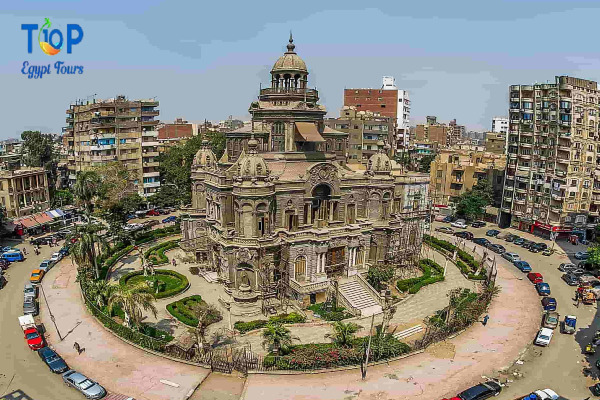Habib Pasha El-Sakakini Palace is a remarkable historical landmark located in Cairo, Egypt. Built during the late 19th century, the palace stands as a testament to the architectural splendor of that era. It is named after its former owner, Habib Pasha El-Sakakini, an influential figure in Egyptian society. Today, the palace serves as a museum, offering visitors a glimpse into the opulent lifestyle of Egypt’s elite during the late Ottoman period.
In this article, we will uncover for you the Habib Pasha El-Sakakini Palace. with Top Ten Egypt.
Architecture and Design Of Habib Pasha El-Sakakini Palace
The architecture of Habib Pasha El-Sakakini Palace reflects a fusion of different styles prevalent during the late 19th century. The palace exhibits elements of Ottoman, Moorish, and European architectural influences, resulting in a unique and captivating design.
The exterior of the palace features intricate stonework, elegant arches, and ornate balconies. The facade is adorned with decorative motifs and carvings, showcasing the attention to detail and craftsmanship of the era. The palace’s interior is equally impressive, characterized by grand halls, lavish reception rooms, and beautifully adorned ceilings.
Historical Significance Of the palace
Habib Pasha El-Sakakini Palace holds significant historical importance in Egypt. It provides valuable insights into the lifestyle and cultural milieu of the Egyptian elite during the late Ottoman period. The palace was not only a residence but also a hub for social gatherings and intellectual discussions, attracting prominent figures from art, literature, and politics.
Habib Pasha El-Sakakini, the palace’s former owner, was known for his contributions to education and his efforts to modernize Egypt. He played a pivotal role in establishing modern schools and promoting intellectual pursuits. His palace became a center for cultural exchange and a meeting place for intellectuals and artists of the time.
Visitor Experience
Visitors to Habib Pasha El-Sakakini Palace can immerse themselves in the opulence and grandeur of the late Ottoman era. Here are some tips for a memorable visit:
Guided Tours: Consider joining a guided tour to fully appreciate the historical and architectural significance of the palace. Knowledgeable guides can provide detailed information about the palace’s history, its former owner, and the cultural context of the time.
Explore the Rooms: Wander through the various rooms of the palace, each showcasing a unique aspect of the period’s lifestyle. Admire the intricate woodwork, the beautiful furniture, and the preserved artifacts that offer glimpses into the past.
Gardens and Surroundings: Take a moment to appreciate the palace’s gardens, which provide a serene and picturesque setting. The well-maintained grounds offer an opportunity for relaxation and reflection.
Photography: Capture the palace’s stunning architecture and interior design, but be mindful of any restrictions on flash photography or specific areas where photography may not be permitted.
Nearby Attractions: Combine your visit to Habib Pasha El-Sakakini Palace with a tour of other nearby attractions, such as the Cairo Opera House or the Cairo Citadel, to make the most of your time in the city.
Location and Accessibility
This Palace is conveniently located in the heart of Cairo, making it easily accessible to visitors. It is situated in the neighborhood of Al-Khalifa, near the Abbasiya district. Visitors can reach the palace by various means of transportation, including taxis, public buses, or private cars.
Conclusion
The Palace offers visitors a fascinating journey into the past, allowing them to experience the grandeur of the late Ottoman period in Egypt. Its architectural beauty, historical significance, and cultural relevance make it a must-visit destination for those interested in Egypt’s rich heritage. A visit to this palace provides a window into a bygone era and an appreciation for the artistic and cultural legacy of the time.



Comment (0)